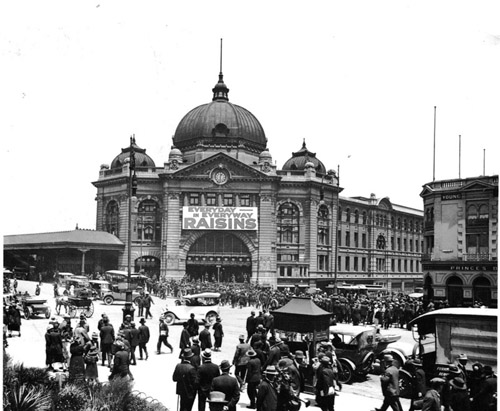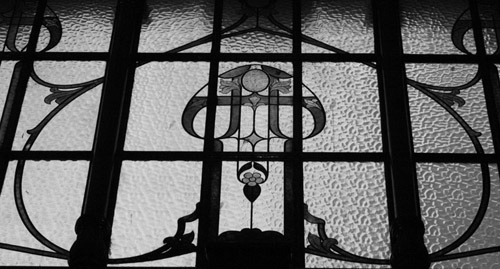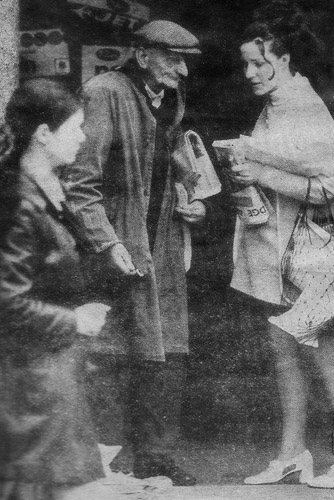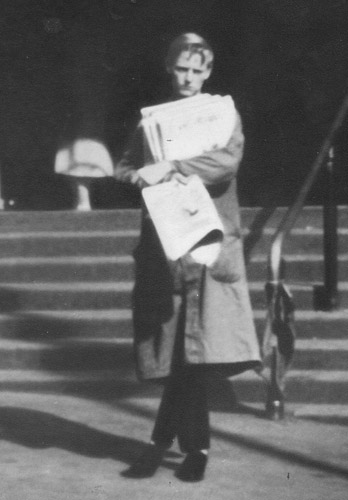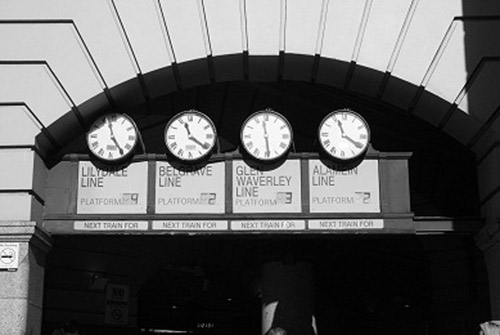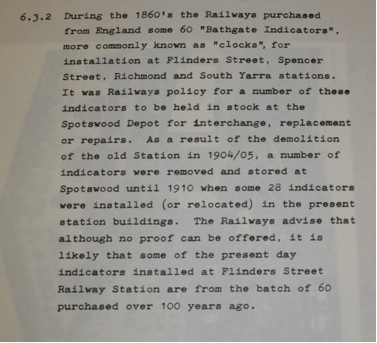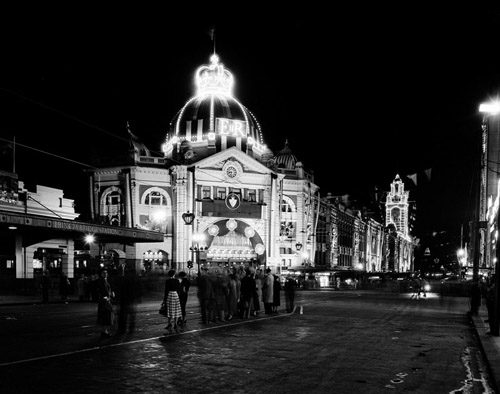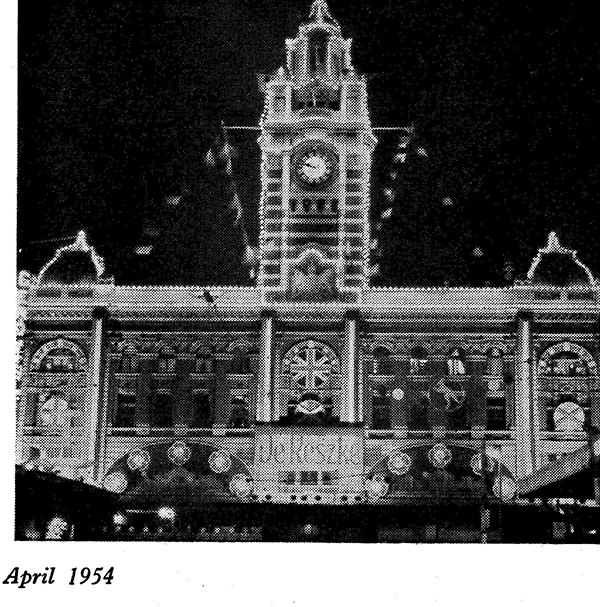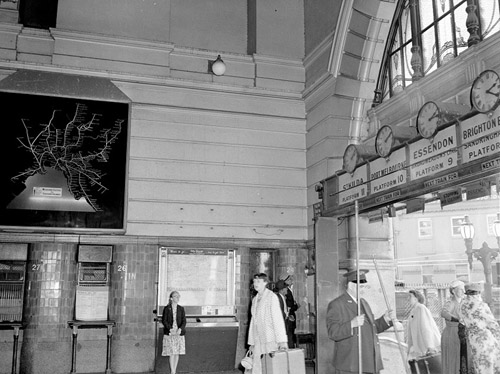UNDER THE CLOCKS: STORIES
Realist Painting of the Station
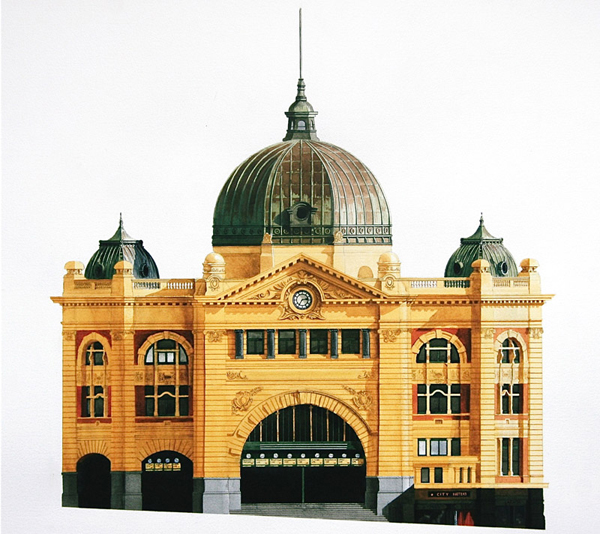
A contempory watercolour painting by Melbourne artist, Jason Roberts. |
Melbourne artist, Jason Roberts, intrinsically detailed watercolours are an attempt to preserve the city’s glorious old buildings. Jason says that history shows that if we don’t appreciate them they are at risk of being torn down and replaced with characterless concrete boxes. This painting of Flinders Street Station was part of an exhibition and he said, surprisingly, it was one of the few that were not sold. It has now found its rightful home with station historian and author, Jenny Davies. |
About the Raisin Banner
Clapp Raisins Banner 1920s
|
"Dear Mrs Davies At last I knew why I’ve kept the enclosed photo for 60 years – I’ve held it in store for your book. It’s an interesting image not only of Flinders Street Station but a wealth of detail of the times. The huge advertisement for “Raisins”, the street lighting, modes of transport and people’s fashions (not one bare head in sight!) bring back memories. I’m well into my 80s and recall “the city and F.S.S” as awe inspiring destinations in the 1920/30s with “bustling crowds” and “huge volumes of traffic”. And where are all the people in the photo heading? The station clock shows 12.30. People’s shadows are quite short indicating the sun was almost directly overhead at the time so it must be Spring or Summer – perhaps the Poms were in Melbourne to play cricket and it’s Saturday and people are going to the MCG after working the (then) Saturday morning shift. Maybe it’s footy finals time!... " |
The Arched Windows
Detail of the Art Nouveu Flemish glass arched window pattern
|
The design for the coloured Flemish glass windows over the main station entrance and the Elizabeth Street entrance was the work of the railways architect, James Fawcett. Fawcett was the Victorian Railways architect who, along with engineer HPC Ashworth, won the Design Competition of 1899. Along with Ashworth, he designed additions to the Spencer Street Head Office. Fawcett designed the illuminations for the station building for the 1901 visit by the King and Queen and the Duke and Duchess of York in 1927. Fawcett introduced the art nouveau motifs to the station design and created many patterns for the pressed metal company, Wunderlich, contributing significantly to the style of the internal pressed metal of the building. His designs also appeared in the interior panelling of the Tait trains. As to exactly what his business relationship was with Wunderlich that is not known in any detail. Fawcett was responsible for the design and furnishing of the Railway Institute rooms on the 3rd floor of the station building. He designed the original VRI Country Branch buildings and many other railway associated buildings. Fawcett became the Victorian Railways Chief Architect in 1919, retiring in 1928. His influence on the architecture of Melbourne has never been fully recognised or appreciated.
|
Selling Newspapers from 1897
Dicko 1969 & 1971 with niece just before he retired
|
Richard Henry Binney and his twin brother John Harold Binney (more commonly known as Harry) were born in Kensington in 1890. Richard who was known throughout his life as Dicko and he was the eldest with two sisters and another brother following. At age seven they were living on the corner of Flinders Lane and Russell Street, whilst their mother ran her dressmaking business in the nearby Eastern Arcade Market. At this age the twin brothers, Dicko and Harry, started selling newspapers at the old Station corner. This was around the time when there was a fish market and a number of oyster stalls along Flinders Street at what is now the current station. As youngsters they would sneak in into Young & Jackson’s and partake of the free lunch. Often they would be chased out but it never deterred them from going back. At around age fourteen both of the boys decided that they wanted to become apprentice jockeys which were not an unusual profession to follow in those days given the fact that they were small in stature and weighed about four stone (25 kgs).Their maternal grandfather was jockey and later a racehorse trainer. Hence their mother was not keen on the idea at all, knowing the sort of life involved. (Incidentally their grandfather rode in the first five Melbourne Cups. Finishing third on a horse called Poet in 1864 as his best result.) So they just continued to sell newspapers and on Saturdays sold race books at the various racetracks around Melbourne. Harry would start selling the Herald at 3 pm which was the “Home Edition” while Dicko started at 4 pm with the “Late Extra Edition”. Dicko worked until just on midnight then he would catch the last train or tram home to Collingwood. Harry finished at 7 pm Monday through to Thursday. On Fridays Harry went through to 8 pm then worked Dicko’s news stand between 8 and 9 pm. This allowed Dicko to go for a bite to eat. |
Dicko selling newspapers
Dicko 1969 & 1971 with niece just before he retired
|
Jenny, I would like to tell you my story – The photo on the top right on the ‘share your story’ page is of me and my grandpa Richard Binney. I am Richard Binney’s eldest grandchild. The photo was taken in 1970 when I was pregnant with Grandpa’s first great grandchild (who was born in January 1971). I worked at L’Oreal of Paris in Collins Street at the time and lived in Caulfield. I caught the train home each evening and always visited Grandpa and picked up the Herald to read on my journey. I recall this particular evening when I visited Grandpa because someone who was a friend of the family (‘Uncle Bernie’ who also worked at the station) was standing nearby and talking to someone else. Grandpa said, ‘They are doing a story’. I didn’t realize that a photo had been taken of us until it was published (together with Grandpa’s story) in the paper the next day. It was a candid shot and ‘one in a million’ really, given that I could have been anyone standing there at the time. In ‘Under the clocks – Selling Newspapers from 1897’ this picture again appears. However the description reads, ‘Dicko in 1969 with his niece, Loretta, just before he retired in 1971’. The description is actually incorrect and should read, ‘Dicko in 1970 with granddaughter Loretta, just before he retired’. Thank you for the lovely memories. |
inside flinders street station: The paper boy
Click here to watch The Age Flinders Street Series: The Paper Boy (Source: The Age)
Around the Station in the 50s & 60s
|
Between 1957 and 1959 I used to meet my little girlfriend “under the clocks”. She lived in Windsor and came to town on the train. I remember the anticipation while waiting and the excitement when I saw her emerging from the crowd on the other side of the ticket barrier. Her mother ran a frock shop and she was always beautifully turned out. Tragically she died of cancer before her 17th birthday. My father was a huge enthusiast of felt hats and he alternated between Ball & Welch (in Flinders Street) and the City Hatters (within the station building) for his purchases. I often accompanied him while he bought his hats. Early in the 1950s my dad thought that I needed physical exercise and sent me to the YMCA Along this stretch of St Kilda Road was the famous Green Mill, clearly identified by its shape. It was later known as the Trocadero Ballroom. On the subject of dancing, I am old enough to have been to a 50-50 dance at the VRI Ballroom, within the station buildings. Thinking about it, that must have been somewhere between 1965 and 1968. |
The Newspaper Boy
Michael Binney at age 17 selling papers on the steps of the station
|
In 1927 Dicko married Kathleen Perriam, a waitress at Clota’s restaurant underneath the Mutual Store and was opposite the Centre Entrance to Flinders St Station. They had 12 children - seven girls and five boys. Dicko’s five boys at one time or another helped Dicko at his news stand, but only one son, Michael, was a newsvendor for several years selling papers at the bottom of the station steps. From January 1960 until September 1962 I worked the stand at the bottom of the stairs with my brothers John and Phillip on Saturday nights - 6 pm till 11.45 pm. I then worked that stand as a full time news vendor until January 1965, then part time again till July 1966. From Monday till Wednesday I started at 1pm and finished at 11.45 pm. Thursday and Friday I worked from 1 pm until 6 pm and on Saturdays from 1962 until 1966 I worked from 8 am until 11.45 pm. You may ask why 11 45 pm? Well, that stand had to be packed up with the covers put on and into the station cloak room by 11.50 as that was when the cloak room closed. We would start packing it away from about 11.20 selling the last of the Heralds until the death knock. In the photo of me on the steps you can see a small hessian bag tied to the rail. Most of the newsboys along the front of the station had one. They were there to put all of the pennies in that were collected whilst selling the paper. The weight of a couple of pound of pennies could weigh you down as well as take up large amounts of room in your money bag or dustcoat pocket. |
About the Clocks
Swanston Street side arch clocks
|
The following extract is from the Report of the Government Building Advisory Council: Presented to the Minister of Public Works 29 July 1975. It is the only mention of the source of the Indicator Clocks found to date.
|
Removal of the Clocks
|
The date of the removal of the clocks is given as 1983 but I would have thought it was a few years earlier as I was living in Perth by then. The clocks were actually replaced by TV screens which were around for awhile although the decision may have been reversed after one day, it took a while for the clocks to be returned. I remember seeing the TV screens from across the road for the first time. I was flabbergasted that this could have happened, not only on ‘eritage-like grounds, but that the digital displays were illegible from the other side of Flinders Street. As a teenager I would look to the clocks for the next Alamein train. If it was some time away, I would catch the No 74 tram out to Hartwell instead. The introduction of the TV screens rendered this journey management tactic useless for awhile! |
Taking out the Bathgate Indicators
|
I have many memories of dismantling the mechanical signalling and migrating to the new computerised Metrol signal control building. One memory that will interest your readers is the day I was involved in removing the old “Bathgate Indicators”. These were not the clocks but the destination signs that were pulled down to advise passengers of the destination and stopping pattern of each train under its respective line and clock. The clocks had already been removed, sometime in 1981 I think, when the new electronic passenger information system was being commissioned as part of the underground loop construction and the commissioning of the new Metrol building. The removal of the clocks had so enraged the Melbourne public that the government promised to replace them but would link them into the new electronic passenger information system which I think was an excellent marriage of style and technology. However, to make room for the return of the clocks with their new electrical system, we had to remove the Bathgate Indicators. I remember it being a relatively warm day and I was positioned on the top of a not so stable step ladder to assist the “Bathgate fitters” to unbolt and remove the boards down to the ground. With 1,000s of people walking past, several bumping the ladder (there was not thought of safety barriers even in those modern times), many pausing to watch, stare or even throw abuse at us. They associated us and the work we were doing with the destruction of “their station” and did not trust the government to honour their promise to return the clocks. The dust from the cavity was incredible and you can imagine how the sweat just attracted it! I was given even more stares and ribbing from my work mates when I returned to our depot on Batman Avenue looking like a black man. But the surprise for the day was finding so much history hidden behind the facade. Unfortunately I didn’t have a camera with me because we found signs relating to the old Inner Circle Line and even remnants of the old Harold Clapp advertisements of ‘raisins’ and ‘eat more fruit’ that had been either partially covered up or built over. PS Until the late 1980s, the following types of indicators existed in the City Rail network. Some were very old and outdated and others not so old.
~ Roo Richards, 2012 (Roo was an apprentice with the railways from 1980 to 1986.) |
Overhauling the Clocks
|
In 1916 the clocks were overhauled by the Melbourne Company of Edmiston & O’Neil Engineers. The brass plates are still on the clocks. Working for Edmiston & O’NeilMy father began his working life at 14 in 1917 for Edmiston & O’Neil which, at that time, were located at 29 Somerset Place off Lt Bourke St, between Elizabeth St and Hardware Lane. He was mainly involved in welding and lathes as they were primarily lift engineers. Dad developed his skills as a general engineer and worked a lot with locks. During the Depression dad had to find some other work and managed the Fawkner Mansions in South Yarra (where we of course also lived). He was able to return to Edmiston & O’Neil and remained an employee until he retired in the early 1970s. The company moved to North Melbourne in later years. Overhauling the Clocks in the 1990sI worked for Edmiston & O’Neil during the years from 1991 to 1997. In about 1995 the railways department approached us to do some work on the clocks. Edmiston & O’Neil no longer did that type of work anymore as the company had changed over the years to be solely a lift manufacturing and servicing company. However, my brother Terry was a qualified watch and clock maker, having been apprenticed and serving in the trade for more than 30 years. He was willing to take the work on. Having regard for the historical nature of the clocks, we did some research on their original appearance and undertook to bring the clocks back to their original specification and to refurbish the clockwork mechanism. The work was phased over a 12 month period as there were only two spare clocks. The railways did the removal and replacement at Flinders Street Station and we picked them up from the North Melbourne Workshop. As Terry lived in Colac, I transported the clocks to Belmont and we met at the McDonalds car park to do the changeover. He would bring the refurbished clock in the boot of his car from Colac and swap it over for the one in my boot. The Colac Herald, Monday, August 5, 1996 featured an article on Terry Robinson on the front page titled, “Passion for restoration leads to major project”. The article states, “...Terry enjoyed taking up the challenge of restoring the 15 double faced clocks. Weighing about 50 kilograms each....All the clocks needing different types of restoration work to be carried out on them. Some had broken or scratched glass, others had burnt out motors, all were covered in pigeon droppings and grime or had worn shafts or brushes and some had holes cut into the original casing....All the work was carried out on the floor of his shed as he didn’t have benches big enough or that could carry the weight of the clock....Once the clocks were operating, he stripped them down and applied a new coat of green heritage paint....We received some strange looks from customers when we were struggling to carry the repaired clock which was wrapped up in brown paper from my station wagon to my brother’s. “I’m sure some people thought we were trying to get rid of a body, with the looks we got,” he said....Having just restored the last clock, Terry said he felt a great sense of achievement and pride in restoring part of such a well known landmark.” The project was completed in late 1996. Unfortunately Edmiston & O’Neil were taken over by Kone Elevators in 1997 (Edmiston & O’Neil’s 100th year of operation) and the company name was lost.
We actually owned the company (E & O'N) for the last ten years of its trading history. Life has a funny way of bringing things together. |
Lighting up the Station
The Decorations for the Royal Tour – 1954 NAA collection
|
Flinders Street Station has been the focus for celebrations of all kinds for over 100 years. It sits at the axis of the main route south and the east west transit of the city. The current building was decorated for the arrival of the Great White Fleet in 1908 even before it was completed. The photo shown above was taken on the occasion of the Centenary of the Victorian Railways in September 1954. The station was decorated for all kinds of celebrations. Various visiting dignitaries and members of the British Royal Family have prompted the Victorian Railways to create spectacular lighting on the station. Early that year the large crown that sat on the top of the dome was created to celebrate the Royal Visit by Queen Elizabeth and the Duke of Edinburgh. (Photo from a private collection) “The design of the decorations for the 1954 Royal Tour was done by the architects of the Way and Works Branch no doubt in compliance with the requests by the government of the day for a spectacular display. Flinders Street Station was the focus for the VR as the Queen travelled from Government House along St Kilda Road on more than one occasion. The lighting of the building was central to the show and I was very involved as I was employed as an engineer with the Electrical Branch from 1952 to 1958. There were thousands of festoon lights installed under contract by the VR architects. As only clear globes were available then, all had to be painted at the Batman Avenue workshop under my supervision. A particular problem was to make the crown jewels ‘sparkle’. They were just panels of various coloured globes and the design was for most of each panel to be turned off and then to rapidly turn some globes on, thus achieving a scintillation. How fast was rapid to be? That had to be tested. I perched on a shelf on Flinders Street with a panel and a variable speed switch while a senior engineer observed the effect from the Princes Bridge entrance. Disaster...the switch had been incorrectly wired to leave most of the lights on and to rapidly turn some off. Fortunately it was deemed to be a better scintillation and it seemed to be adequate as we received no complaints. The installation was completed by the time the Queen arrived. The Dome was a great place to view the real crown jewels. We could not match them. This photo would probably have been taken from the old SECV Offices in Flinders Street using a telephoto lens. I would expect that the man in view would have been a contractor as a VR employee would have at least one assistant with him! The festoon lights on the dome ribs were installed after the crown. I thought the jewels had more than 12 globes per piece but it was a long time ago! |
Railway Decorations
The Decorations for the Royal Tour – 1954 NAA collection
|
Decorated railway buildings, many of which were the focal points in the royal tour, played their part in creating the gay atmosphere that, everywhere in Victoria, greeted the Queen and her Consort, last month. In designing the decorations, the guiding principle observed by the Department’s technical staff was to allow the structure of the building to decide the form of its decorations. As a result, harmonious and pleasant effects were obtained without impairing spontaneity in the note of welcome.
With its main features outlined in amber coloured globes that gave a rich, golden light, the Flinders-st station building was most impressive. The crown surmounting the dome was 18 feet in diameter and weighed 23/4 tons. Made at Spotswood Workshops from steel pipe framing on a wooden base, it was sheeted with guilded masonite and plaster. The jewels in the crown were represented by red, blue, and green globes which continually twinkled – an effect obtained by motor driven switches. To outline the crown and dome 2,050 globes were used; on the Elizabeth-st end were 1,650 globes. |
Not Meeting Under the Clocks!
|
I signed up for the armed forces during WWII when I was 19. I’d done my Basic Training at Shepparton for 6 weeks and was waiting to be posted. Us rookies were waiting to be posted and we were camped in Bay 13, MCG, with guards and so on. There were stretchers set up all over the place. We weren’t supposed to be out but a few of us called up all the girls we knew and asked them to meet us under the clocks. We then gathered across the road at the Cathedral and watched how many turned up. They were all looking at each other wondering what was going on! We were probably there for about half an hour or so. We had to get back before we were missed. We didn’t actually go over to the station as we all had to head out the next day. I was first posted to the No. 1 Air Medical Evacuation Unit which was formed in Sandgate, Queensland. I had several other postings in New Guinea including the 2nd 7th Army General Hospital and the 83 Army Co-operations Wing that included army, navy and air force intelligence personnel. My wife was not one of the girls I called to ‘not meet under the clocks’. I hadn’t met her then. |

